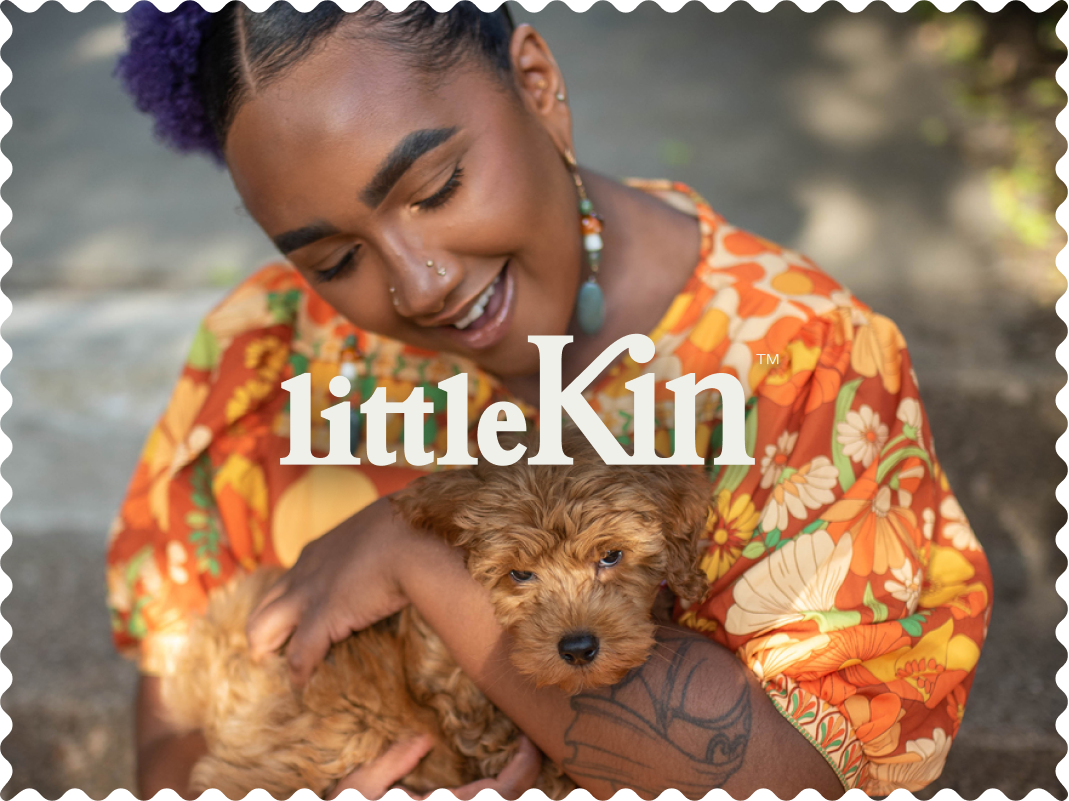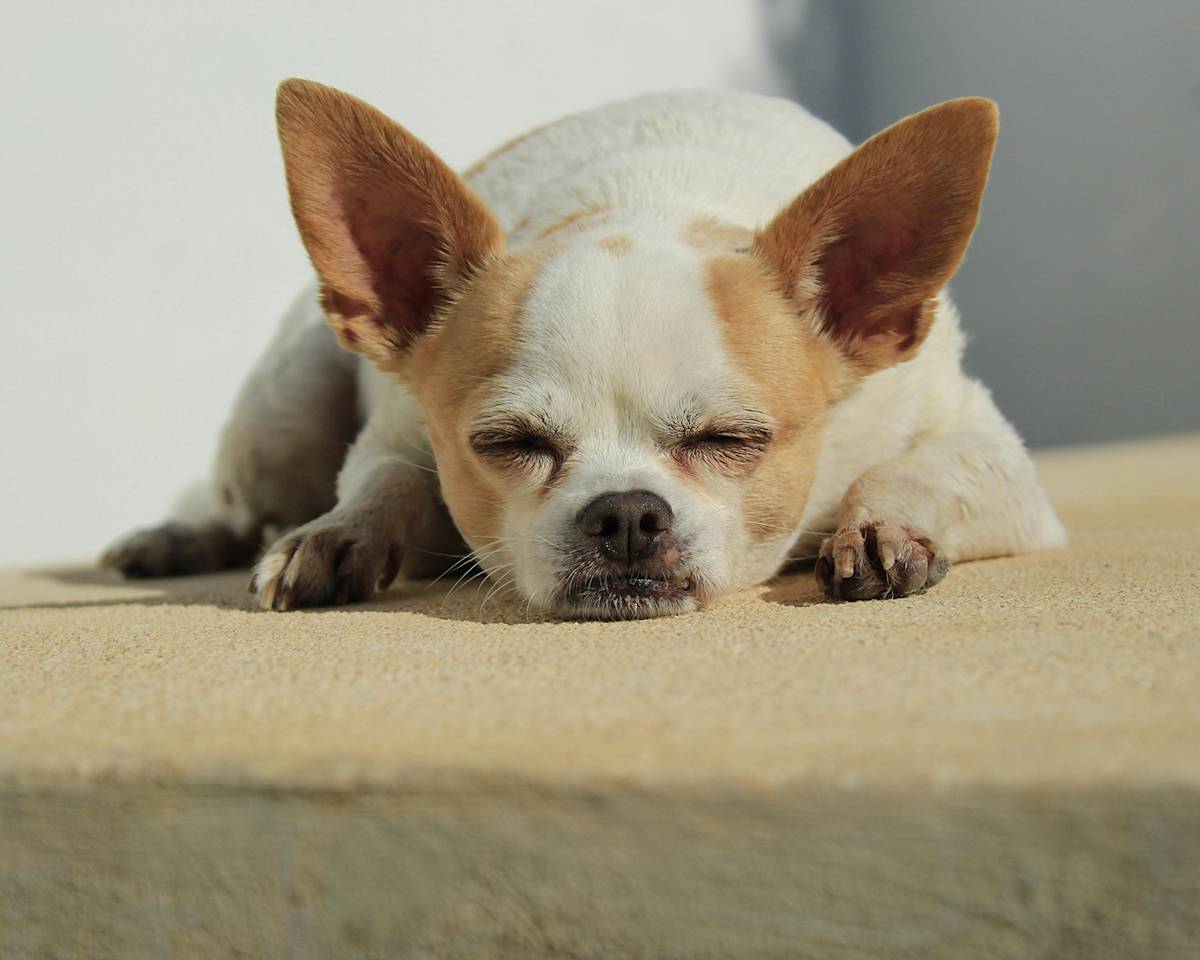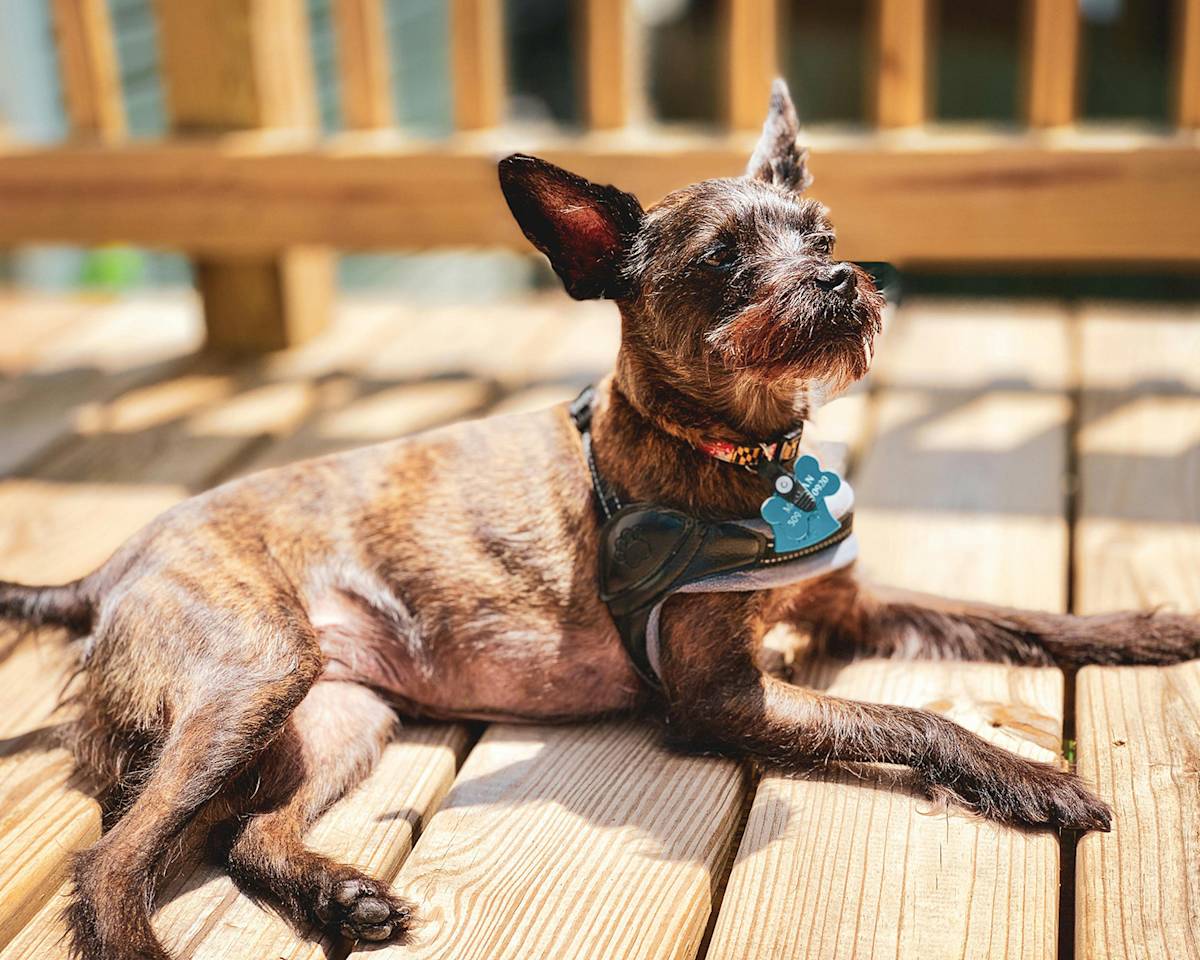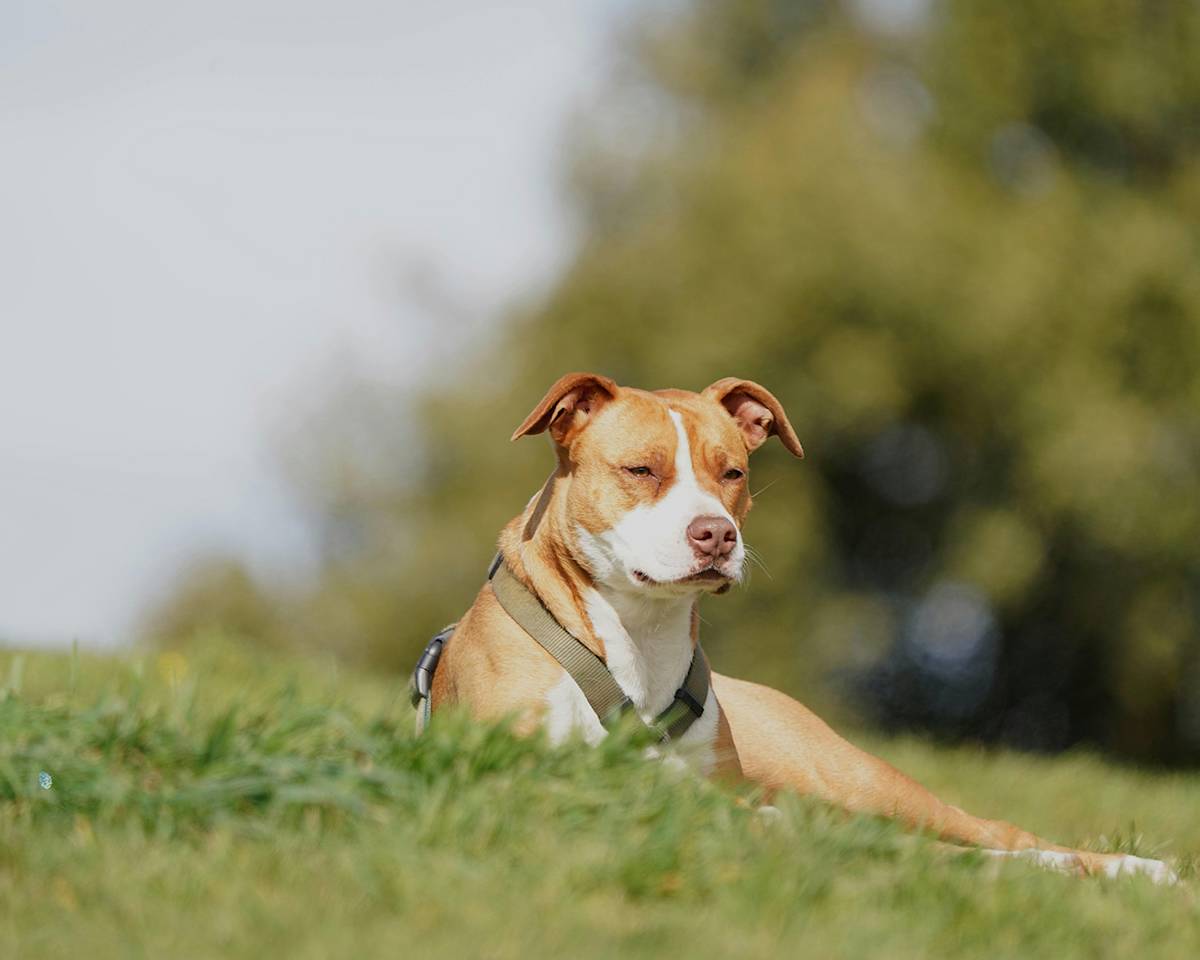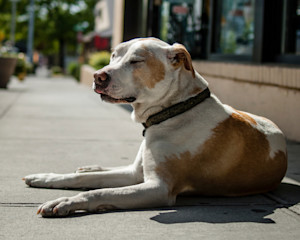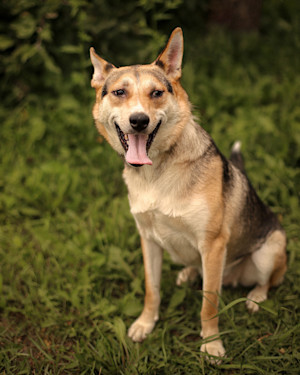Do Dogs Sunbathe? Here’s Why Your Dog Loves the Sun
They just can’t get enough

Share Article
In this article:
Why do dogs lie in the sun? Should you encourage your dog to sunbathe? Is too much sun bad for dogs? How to keep your dog safe while sunbathing Signs your dog has gotten too much sun FAQs
I once spent many hours researching dog cooling mats before excitedly whipping one out on a mega hot day, expecting my fluffy dog Lucy to fall to her knees in gratitude. Instead, she looked at me in disgust and strolled into the garden to lay in the blazing sun.
Just the other week, I was worried that my other dog, Sherlock, had overheated after a run, so I bundled him in the shower to cool down. Fast-forward 10 minutes and he’d taken himself outside to dry off in the sun. From chats with other pet parents, I know these stories aren’t unique.
We’re so terrified of our beloved pets getting heat-stroke, yet all the while they’re sticking their middle paws up at us as they sunbathe in furry jackets. What’s the deal? Why are our dogs such little weirdos? Let’s find out.
Why do dogs lay in the sun on a hot day?
Why do so many dogs insist on roasting themselves on a baking hot day? We asked the experts to shed light on some popular theories.
Boost vitamin D
Vitamin D is essential for healthy bones and teethopens in new tab in both humans and dogs, but while the human body can produce vitamin D by exposing our skin to the sunopens in new tab, the jury’s still out on whether dogs can do the same. There’s a concerning amount of misinformation online around this topic, with multiple sites confidently stating that dogs synthesise vitamin D3 via sunlight, despite many studies reporting that dogs (and cats) are not able to synthesise vitamin D cutaneouslyopens in new tab.
Confused, I turned to Dr Eunice Lim, a mixed practice vet and ambassador of Pet Urnopens in new tab. Dr Lim tells me that the general consensus is that dogs cannot produce enough vitamin D from sunlight to sustain their daily needs, meaning they have to rely on dietary supplements.
“However, there’s not been enough studies on all breeds of dogs, and I’m wondering if less furry breeds or certain breeds have more vitamin D precursor in their skin compared to others,” she suggests.
“With that being said, even if some breeds are able to synthesise more vitamin D in the skin after sun exposure than others, I doubt that it’s enough to meet their metabolic requirements.”
Shed dead hair
Are you even a pet parent if you don’t find a coating of dog hair on everything you own? Loads of things influence when and how much a dog sheds, including breed, hormones, and the changing of the seasons, which is due to something called photoperiod shedding. This basically means that dogs shed more when the days are longer, as they’re exposed to more daylight.
However, those of us in the UK can confirm that daylight doesn’t equate to sunlight, so is there any evidence to support the fact that sunbathing can speed up the shedding process?
“I searched for hours for the answer to this and have come to the conclusion that the pathway is still unknown as it’s influenced by too many other factors like age, genetics, nutrition, etc,” reveals Dr Lim. “To understand the whole process we have to understand how the canine hair follicle and cycles work, which is incredibly complexopens in new tab – there’s still so much we don’t know.”
So, maybe lying in the sun will help your dog shed their fur, maybe it won’t. We’re going to need some more research, science bods.
Reduce stress
Serotonin is a neurotransmitter and hormone that helps regulate many processes in the body, like mood and sleepopens in new tab. In humans, increased sunlight exposure is linked to increased serotonin turnoveropens in new tab and improved mental healthopens in new tab, so is it the same for our canine companions?
“Theoretically, the pathway of serotonin production from sunlight exposure is the same for all vertebrates, which includes humans and dogs,” explains Dr Lim. “There’s currently no research (that I can find) that’s able to prove that more sunlight exposure in dogs is associated with more serotonin production, likely because serotonin is also influenced by many other factorsopens in new tab, such as olfactory stimulation, food, companionship etc. However, I definitely believe that dogs benefit from sunbathing and have reduced stress levels, in part due to serotonin production.”
To get warm
Sunbathing for dogs could be as simple as temperature regulation, due to their core body temperature being higher than ours.
“A dog’s temperature can range from around 37.5–39C (99.5–102.2F),” explains Connie Garvey, a registered vet nurse at Woodgreen Pets Charityopens in new tab. For comparison, normal body temperature of a healthy adult human is around 37C (98.6F)opens in new tab, and 38C (100.4F) or higher would be considered a fever for us.
Garvey reveals that dogs are actually hard-wired to pursue ‘warm cinnamon bun’ levels of comfort, telling us that most dogs instinctively seek out the warmth of another dog or person.
“They’re a social species, and many dogs find the physical contact and warmth comforting,” she explains. “This need for warmth might also be why your dog loves to lay in the sun.”
For dogs suffering with body pain, this elevated warmth can be a tonic for their discomfort as heat allows more blood flow to the areaopens in new tab, which can help reduce pain and stiffness, and relax muscles. “The heat from the sun may certainly be relaxing and soothing for stiff muscles and/or inflammation in dogs’ joints,” confirms Garvey. “This could be a reason that dogs with joint painopens in new tab often seek warmth, or sunbathe.”
Should you encourage your dog to sunbathe?
OK, so we’ve figured out that there are some benefits to dogs basking in the sun, so is sunbathing an essential pastime for our pooches? Should we be wheeling them out once a day for a UV sesh? Not quite…
“It’s preferable to encourage dogs to stay in the shade, with the option to move into sunspots,” advises Garvey. “Some dogs can self-regulate, which means they’ll instinctively move back into the shade or drink water to cool down if they feel too hot. However, other dogs may stay too long in the sun, especially if they’re choosing to stay close to their humans.”
Garvey also warns that puppies, senior dogs, overweight pooches, brachycephalic breeds (like Frenchies, Pugs, and Bulldogs), and dogs with known health conditions (including heart or respiratory issues) shouldn’t be allowed to lay in the sun at all: “These dogs could be at risk of extreme heat exhaustion if exposed to full sun.”
Is too much sun bad for dogs?
While sunbathing might seem safer than walking your dog in the heat, it doesn’t come without risks. Heat-stroke in dogs is incredibly serious and occurs when their body temperature rises above 41C (105.8F)opens in new tab, which can lead to organ failure, neurological issues, and death. With their furry jackets and inability to cool down by sweating, lying in the sun for too long on a hot, humid day can put dogs at increased risk of heat-stroke or heat exhaustion.
Garvey tells us that dogs with light-coloured fur or sensitive skin can also be at risk of sunburn, especially around the ears where fur is more sparse. Some dogs may even be photosensitive to sunlight, which can cause them pain or discomfort. “These dogs are also more susceptible to skin cancer,” warns Dr Lim.
How to keep your dog safe while sunbathing
As Garvey says, most dogs are usually smart enough to move out of the sun when they’ve had enough, but we must remember that we’re the responsible adults in charge and we need to be party poopers when necessary. Starting with…
Discourage playing or any energetic activity in the sun as this can accelerate heat-related problems.
Always ensure your dog has access to shade and fresh, cool drinking water.
Check the temperature of shaded areas – on a humid day it may be safer to stay indoors.
Don’t let your dog lay in the midday sun, when it’s at its strongest.
Supervise your dog at all times and move them to a cooler area if they show signs of over-heating.
Speak to your vet to see if they recommend applying pet-safe sunscreen.
Wait, pet-safe sunscreen? What’s that? “Pet-safe sunscreens are formulations that protect our dogs from UV but don’t contain substances often found in human sunscreens that are toxic to dogs,” explains Dr Lim. “These include zinc oxide and para-aminobenzoic acid (PABA).” Slip, slop, slap, my friend.
Signs your dog has gotten too much sun
When humans get a bit too much sun, we can usually revive ourselves with electrolytes and a nap in a cool room. For dogs, the consequences are much more serious, so here are the warning signs to look out for, according to the Royal Veterinary Collegeopens in new tab.
Early warning signs of heat-stroke
Excessive panting.
Seeking shade or water.
Pacing, restlessness or agitation.
Drooling.
Increased heart rate.
Vomiting or diarrhoea.
Advanced signs of heat-stroke
Lethargy.
Confusion.
Weakness/collapse.
Seizures.
“All these signs should be taken seriously,” warns Dr Lim. Your priority should always be to cool your dog down first, before taking them to the vet.
Bottom line: why dogs lay in the sun on a hot day
Dogs lay in the sun on boiling hot days for a number of reasons – for many it’s because warmth = cosiness. For dogs with joint pain or stiffness, the warmth of the sun can give them some welcome respite from symptoms. A little sun sesh can also be a mood booster for dogs, potentially increasing serotonin and lowering their stress levels. The sun might also help some dogs synthesise vitamin D through the skin, and potentially help dogs shed their fur, but more research needs to be done on both those topics. Hey scientists – get back in the lab(rador).
FAQs
Can an overdose of sun be harmful to my dog?
It sure can. Heat stress can lead to heat exhaustion, which can lead to heat-stroke. Heat-stroke is often fatal in dogs so look out for early warning signs of drooling, excessive panting, restlessness and red gums. More advanced signs include lethargy, collapse, and seizures. Prioritise cooling your dog down with cool water and a fan, before rushing them to the vet.
Why does my dog keep lying in the sun?
Dogs have higher core body temperatures than us humans, so in cooler months you might find your dog making the most of any slither of sunlight they can find, to help raise their temperature. Most dogs have an instinct to be warm and cosy, which often involves making the most of the sun’s rays.
Why does my dog sit in the sun in the summer?
Some dogs just can’t get enough of the sun, even on a baking hot day. Your sun-loving dog may simply dig the feeling of warmth on their skin, or they might be into the mood boost they get from a snooze in the sun. Dogs suffering from joint pain or stiffness might feel some relief of their symptoms when lying in the sun.
Is it safe for my dog to sunbathe on a hot day?
It depends on the dog – many healthy dogs know their limits and will seek shade once they’ve had enough, though they should always be supervised and have access to fresh drinking water and a shaded area. Keep an eye out for early signs of heat stress, like excessive panting, drooling, and increased heart rate. Puppies, older dogs, overweight dogs, sick dogs and brachycephalic breeds shouldn’t be allowed to lay in the sun as they have an increased risk of heat-stroke.
Resources
Shahraki, Reza Gholipour, et al. “A Study on the Effects of Vitamin D Supplementation on Hematological Parameters and Serum 25-hydroxy Vitamin D in Healthy Dogs.opens in new tab” BMC Veterinary Research, vol. 20, no. 1, May 2024.
Zafalon, Rafael Vessecchi Amorim, et al. “The Role of Vitamin D in Small Animal Bone Metabolism.opens in new tab” Metabolites, vol. 10, no. 12, Dec. 2020, p. 496.
Welle, Monika M., and Dominique J. Wiener. “The Hair Follicle.opens in new tab” Toxicologic Pathology, vol. 44, no. 4, Mar. 2016, pp. 564–74.
Professional, Cleveland Clinic Medical. “Serotoninopens in new tab.” Cleveland Clinic, 7 May 2025.
Lambert, Gw, et al. “Effect of Sunlight and Season on Serotonin Turnover in the Brain.opens in new tab” The Lancet, vol. 360, no. 9348, Dec. 2002, pp. 1840–42.
Wang, Jie, et al. “Association Between Sunlight Exposure and Mental Health: Evidence From a Special Population Without Sunlight in Work.opens in new tab” Risk Management and Healthcare Policy, vol. Volume 16, June 2023, pp. 1049–57.
Alberghina, Daniela, et al. “Serum Serotonin (5-HT) in Dogs (Canis Familiaris): Preanalytical Factors and Analytical Procedure for Use of Reference Values in Behavioral Medicine.opens in new tab” Journal of Veterinary Behavior, vol. 32, May 2019, pp. 72–75.
Daniela, Neagu, et al. “The Management of Arthritic Pain in Dogs – a Review.opens in new tab” Scientific Papers Journal VETERINARY SERIES, vol. 66, no. 4, 15 Dec. 2023, pp. 137–146.
Bruchim, Yaron, et al. “Pathophysiology of Heatstroke in Dogs – Revisited.opens in new tab” Temperature, vol. 4, no. 4, 2 Oct. 2017, pp. 356–370.
Heatstroke in Dogs and Cats - Prevention, Symptoms and First Aid Tips for Pet Ownersopens in new tab, Royal Veterinary College, rvc.co.uk.
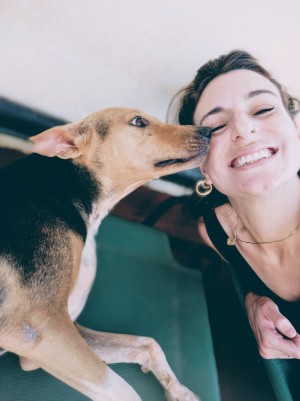
Lisa Bowman
Lisa is a writer whose work has been featured in the likes of Stylist, Metro and The Guardian. She spends her days at a computer so she can bankroll her two rescue dogs, who may or may not be The Cutest Dogs in the World.
Related articles
![Avoid heat stroke in dogs by sprinkling in the backyard with your dog]()
Heat-Stroke in Dogs: Signs, Treatment & Prevention Expert Advice
How to take precautions for your pup when temperatures rise
![a woman looks at a little white dog in concern]()
How to Tell If Your Dog Is Sunburnt
A furry coat is not an SPF
![Dog sunbathing in the sun on pavement]()
When is it Too Hot to Walk Your Dog?
Even if it’s nice for us, it can very easily be too hot for your pup
![dog panting with tongue out]()
This Simple Tongue Trick Could Save Your Dog’s Life This Summer
Your pup’s tongue is sending you important temperature signals
